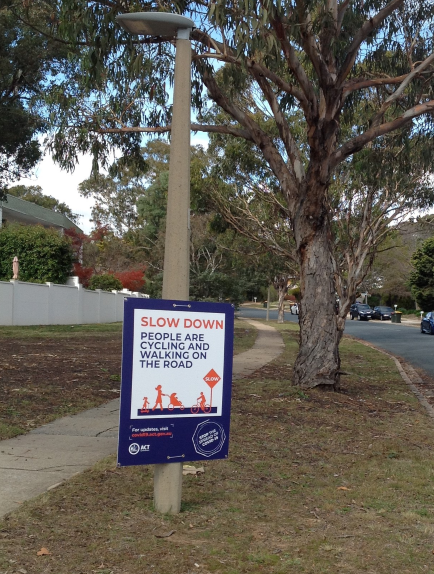
Canberra’s suburban streets have recently experienced a walking and cycling boom. The ACT Government is working with local residents’ groups to encourage people to slow down and share the road with their neighbours who are walking and cycling.
Restrictions on organised sport and other activities at the height of the COVID-19 restrictions, meant more people were staying local: working, shopping and exercising in their suburb and more people were on our suburban streets.
With physical distancing here to stay for the foreseeable future, Slower Streets was developed to assist people who were walking and cycling and using some of the road for exercise. Slower Streets is consistent with the ACT Government adoption of the Safe System approach where lower speeds are critical to preventing road trauma.
Slower Streets was an initiative developed in partnership with walking and cycling groups and delivered by self-nominating residential organisations and networks to encourage people to slow down and look out for their neighbours.
Slower Streets also contributes to residential communities that support children to ride and walk to school. It compliments other programs such as Active Streets and the Ride or Walk to School Program.
Slower Streets did not change speed limits. It was just an invitation to look out for each other.
The initiative also asked visitors, who may use suburban roads to and from their work, appointments and play, to check their speed and to slow down.
The ACT Government provided signs and some basic guidance about how to place them.
Local residential communities installed the signage according to local circumstances and may do additional communications about walking and cycling locally.
Slower Streets was rolled out in 20 suburbs based on suburbs self-nominating through their local community organisations and networks and being able to meet our basic requirements. The participating suburbs are: Ainslie, Aranda, Barton, Braddon, Canberra Lakes Estate (Belconnen), Crace, Downer, Farrer, Garran, Gowrie, Hackett, Kingston, Macquarie, Monash, O’Connor, Throsby, Turner, Watson, Weston and Yarralumla.
What we did
The ACT Government made corflute signs available and provided guidance to residents about appropriate placement of the signs. It was offered on a limited basis to enable us to provide resources to communities that wish to give it a try.
The initiative was based in our view that residents are best placed to decide if and how this works in their local suburb. Volunteers worked through their local community organisations and networks.
Participants were asked, at a minimum to:
- Think about how Slower Streets might work in their suburb.
- Register their interest with the Active Travel Office and discuss where they would put the signs (most suburbs were allocated about 10-12 signs or according to need).
- Install the signage around their suburb.
- Be willing to discuss the initiative with their neighbours using their communication channels (newsletters, social media etc).
- Provide us with feedback about how it went in their suburb.
Frequently asked questions
Why do we need to slow down on residential streets at this time?
As the COVID-19 restrictions began to ease, more people continued to walk and cycle in their suburb and they are giving each other more space. Slower Streets was developed to assist neighbourhoods who are walking and cycling and may need to use some of the road for exercise.
Slowing down helps to contribute to safer and friendlier neighbourhood streets and people have indicated that they want it to continue.
Why were there more people walking and cycling on residential streets?
There are a range of factors increasing walking and cycling on residential streets. One factor was the restrictions on organised sport and other activities. Also, many people are following the advice to avoid unnecessary travel by working from home and visiting their local shops, avoiding large shopping centres.
This is not an enforceable requirement. It is simply a request to people driving to be on the look-out for their neighbours who are walking and cycling through residential streets.
Will it be safe to walk or cycle on the road?
People who are walking or cycling are still encouraged to be vigilant looking and listening for motor vehicles. Since restrictions have eased, traffic on some of our roads has largely returned to pre-pandemic levels. If you are walking on the road, the ACT Road Rules Handbook suggests you walk on the right hand side so you can see oncoming traffic. Check out our other guidance about sharing roads and paths.
Is Slower Streets now finished?
No, but we are unable to take on other suburbs at this time.
All of the suburbs that joined Slower Streets are keen to continue the initiative.
Slower Streets uncovered community sentiment that many people want their residential streets to be safe for people to walk, cycle and play.
The ACT Government has undertaken to explore Slower Streets further as part of the ACT Transport Strategy (PDF ), acknowledging that slower speeds are one part of making streets safer and more welcoming for people to walk, cycle and play. Other ACT Government policies recognise that walking and cycling can deliver other benefits in health, safety, community connection and for the environment.
Whilst the ACT Government will not be issuing any more signs at this stage, we encourage communities to continue local conversations about what they value and what they can do to help make their residential streets friendlier for people.


